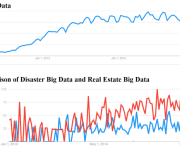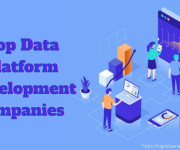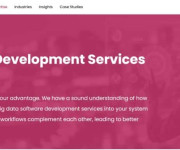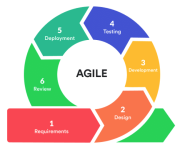How Data Engineering Services Are Reshaping Global Business Strategies
TL;DR
Data engineering services have evolved into a critical pillar of enterprise strategy. They empower businesses to manage massive datasets, optimize decisions, and uncover hidden insights. In 2025, companies that leverage big data engineering services are achieving faster innovation, stronger operational efficiency, and a data-driven edge over their competitors.
Introduction
The world runs on data — every click, transaction, and interaction creates a digital footprint. Yet, raw data by itself holds no value unless it’s structured, processed, and interpreted correctly. This is where data engineering services play a transformative role.
These services create the pipelines, frameworks, and systems that move data from scattered sources to a centralized, reliable foundation ready for analytics and AI. From global corporations to emerging startups, businesses are realizing that strategic data engineering is not a back-end task anymore — it’s a driver of growth and innovation.
The Role of Data Engineering in the Modern Enterprise
Every major organization today depends on seamless data flow — across departments, geographies, and digital systems. Data engineering services ensure that this flow is clean, structured, and secure.
They enable enterprises to:
- Consolidate multiple data sources into a single view
- Enable real-time analytics for faster decision-making
- Build scalable architectures that grow with business needs
- Support AI and machine learning models with consistent, high-quality data
- Enhance data governance and compliance in regulated sectors
Meanwhile, big data engineering services extend these capabilities to handle massive volumes of structured and unstructured data. They rely on distributed systems, cloud platforms, and automation tools to manage billions of data points across business units and time zones.
Why Data Engineering Services Matter for Global Business Strategy
In 2025, businesses are no longer competing on product or price alone — they’re competing on data intelligence.
1. Accelerating Data-Driven Decision-Making
Executives can’t afford to rely on intuition. Real-time analytics powered by data engineering lets organizations make fast, evidence-based decisions — from demand forecasting to customer experience optimization.
2. Powering Predictive and Generative Analytics
Modern data engineering pipelines enable predictive modeling, anomaly detection, and even generative AI use cases — allowing businesses to forecast outcomes and simulate future scenarios.
3. Reducing Costs and Technical Debt
Automated data pipelines minimize redundant tasks, reduce infrastructure waste, and ensure sustainable scaling without skyrocketing costs.
4. Enabling Personalization at Scale
Retail, healthcare, and finance sectors are leveraging data engineering to personalize customer interactions in real time — improving retention and engagement metrics.
5. Strengthening Risk and Compliance Management
Well-engineered data frameworks ensure data lineage, access control, and traceability — essential for meeting compliance and governance requirements globally.
Architecture That Drives Transformation
Modern data engineering architectures blend multiple components:
- Data Ingestion Layer: Captures data from APIs, databases, sensors, and applications.
- Transformation Layer: Cleans, standardizes, and enriches data for analytics.
- Storage Layer: Combines data lakes for flexibility and data warehouses for structure.
- Processing Layer: Uses distributed systems to analyze large-scale data.
- Access Layer: Provides secure, self-service access for analysts, AI systems, and business tools.
Enterprises adopting modular, cloud-native architectures can expand or modify these layers seamlessly — ensuring long-term scalability and innovation.
Big Data Engineering Services: Building for the Next Decade
As global data volumes continue to double every two years, traditional systems simply can’t keep up. Big data engineering services offer the resilience and speed needed for this new reality.
Key focus areas include:
- Real-time data processing with stream analytics and event-driven systems
- Cloud migration and hybrid architectures for agility and cost control
- AI-assisted data quality checks for reliability at scale
- Data automation frameworks that reduce manual oversight
- Edge data engineering for IoT and remote operations
These systems are shaping the foundation for data-driven economies, especially as enterprises adopt multi-cloud ecosystems and federated data models.
Trends Defining Data Engineering in 2025
- AI-Augmented Pipelines: Machine learning is now optimizing pipeline performance, detecting anomalies, and automating data transformations.
- Data Mesh Adoption: Decentralized architectures allow teams to own their data domains while maintaining global consistency.
- Real-Time Analytics Becomes the Norm: Batch processing is being replaced by streaming-first designs for instant insights.
- Data Observability Platforms: Enterprises are investing in tools to monitor data health, lineage, and reliability continuously.
- Privacy-Driven Engineering: Built-in encryption, anonymization, and compliance mechanisms are becoming default components of architecture.
- Sustainability and Green Data: Optimizing compute resources and reducing data storage waste are now key CSR initiatives for large enterprises.
Strategic Implementation Roadmap
Building a modern data engineering strategy involves:
- Auditing Current Infrastructure: Identify silos, redundancies, and bottlenecks.
- Defining Business Objectives: Tie data initiatives directly to revenue, cost, and customer KPIs.
- Selecting the Right Stack: Choose scalable technologies aligned with cloud or on-prem ecosystems.
- Automation First: Automate ingestion, transformation, and monitoring to ensure reliability.
- Investing in Talent: Skilled engineers and data architects remain the most critical assets.
- Continuous Optimization: Regularly evaluate pipeline efficiency, storage utilization, and data quality.
Challenges and How Leading Enterprises Overcome Them
Even with all the technological progress, implementing data engineering services at scale comes with its own set of challenges. However, what separates leading enterprises from the rest is how strategically they respond to these hurdles.
One of the most persistent issues organizations face is data silos and duplication. When information remains scattered across departments, it creates fragmented insights and inconsistent reporting. Top-performing companies address this by establishing centralized data cataloging systems and robust governance frameworks that ensure data remains accessible, standardized, and trustworthy across the organization.
Another growing concern is high infrastructure costs, especially as businesses scale their data pipelines and real-time analytics workloads. These costs can easily slow down innovation if not managed effectively. Forward-thinking enterprises combat this by implementing cloud cost optimization strategies and leveraging tiered storage systems that balance performance with affordability.
Then comes the ever-present challenge of data quality. Inaccurate or incomplete data directly impacts decision-making, eroding confidence in analytics. To mitigate this, companies are turning to automated data validation, anomaly detection algorithms, and machine learning-powered cleansing techniques to maintain a steady flow of high-quality, reliable information.
Security and compliance have also become major areas of focus, especially with increasing global data privacy regulations. Breaches or non-compliance not only carry financial penalties but can seriously harm brand reputation. Leading organizations are countering this through zero-trust security architectures, end-to-end encryption, and role-based access control, ensuring sensitive data remains protected at every step of its journey.
Lastly, the talent gap continues to challenge many enterprises. The demand for skilled data engineers far exceeds supply, making it harder to maintain momentum on key projects. Innovative businesses are addressing this issue through continuous upskilling programs, the adoption of AI-assisted engineering tools, and partnerships with specialized service providers to bridge resource gaps efficiently.
By recognizing and proactively addressing these challenges, enterprises are not only improving their data ecosystems but also gaining a competitive edge in the era of big data engineering services.
The Business Impact: Turning Data into Strategy
Companies investing in data engineering services report measurable outcomes:
- 30–40% faster decision-making cycles
- 25% reduction in operational inefficiencies
- Significant increase in data-driven product launches
- Enhanced resilience through predictive analytics
In essence, the smarter the data infrastructure, the faster a business adapts to change.
Trending FAQs on Data Engineering in 2025
Q1. How is AI changing the role of data engineers?
AI is automating repetitive tasks like pipeline optimization and error detection, allowing data engineers to focus on higher-value architecture and business strategy design.
Q2. What’s the difference between data engineering and data science?
Data engineering builds and maintains the infrastructure that enables data science. Without well-engineered data pipelines, even the best models fail to deliver accurate insights.
Q3. Why are big data engineering services critical for global enterprises?
They allow companies to handle high-volume, high-velocity data — powering real-time analytics and innovation across distributed systems and international operations.
Q4. How can organizations ensure sustainable data growth?
Through automated archiving, compression, and sustainable compute practices that reduce unnecessary data duplication and energy consumption.
Q5. What future trends will define data engineering in the next five years?
Expect stronger integration between AI and data pipelines, federated data governance, privacy-preserving computation, and sustainability-focused engineering.
Q6. Is cloud migration necessary for modern data engineering?
While not mandatory, cloud and hybrid models provide flexibility, scalability, and cost efficiency that on-prem systems often can’t match.
Q7. What’s the biggest challenge companies face today?
Aligning data engineering investments with actual business outcomes. Many organizations focus on tools before strategy — the reverse approach yields better ROI.
Conclusion
The evolution of data engineering services marks a turning point for enterprises worldwide. In a landscape where data doubles every few years, strategic engineering defines who leads and who lags.
Companies that adopt big data engineering services with automation, AI integration, and strong governance will not only thrive in 2025 — they will shape the future of digital business itself.
The message is clear: Data isn’t just an asset anymore; it’s the architecture of strategy.
























